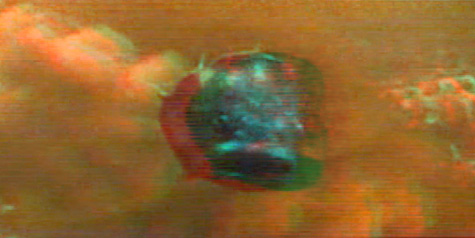
Paul Gauguin, "Pandora" (1892)
What was it like before the internet was invented? Can you remember? Where did all that pent-up aggression go before you were able to express your rage with the world via the medium of the comments thread underneath a video of a cat falling into a pond? Were we all walking around corking a volcano of white-hot fury, clenching and unclenching our fists, unable even to lol or rofl to let off much-needed steam? And what about all those knee and cushion and peanut butter fetishists, trapped in loveless marriages, unable to voice their darkest passions in the anonymity of the chatroom?
The triumphant rise of the lonely voice of boiling frustration and melancholy has transformed the way we interact with culture these days, which brings us on to Avatar, James Cameron’s big, loud, colourful, enjoyable, silly 3D film about magical blue cat-men who live in a neon jungle planet. In it, a soldier in a wheelchair gets to hop and skip with the big blue aliens via a lookalike avatar while his ‘real’ body is passive and immobile, in a brilliant bit of self-reference that has made the film wildly successful among its passive and immobile audiences, perhaps disturbingly so. CNN quotes a blogger named Mike, whose comments on one of many discussion forums for the film characterize what appears to be a widespread phenomenon:
Ever since I went to see Avatar I have been depressed. Watching the wonderful world of Pandora [the neon jungle planet] and all the Na’vi [the magical blue cat-men] made me want to be one of them. I can’t stop thinking about all the things that happened in the film and all of the tears and shivers I got from it. I even contemplate suicide thinking that if I do it I will be rebirthed in a world similar to Pandora.
Another poster, who wisely opts for a psedonym (“Eltu”), comments:
When I woke up this morning after watching Avatar for the first time yesterday, the world seemed … gray. It was like my whole life, everything I’ve done and worked for, lost its meaning. It just seems so … meaningless. I still don’t really see any reason to keep … doing things at all. I live in a dying world.
Evidently for Mike and “Eltu,” the experience of seeing the film unlocked a more profound psychological disquiet that would be insensitive to diagnose. But haven’t we all had similar, if less dramatic, reactions when reaching the end credits of a film we’ve invested in emotionally (for me, it’s Tremors every time)? Who wasn’t depressed when they realized R2D2 wasn’t real? Or elated that the Ewoks weren’t? That’s the nature of art’s power to move (that it’s ephemeral) and the reaction evidence of the possession of a soul. And it might be suggested that the presence of a forum to voice their despair led these writers to exaggerate their angst in a perfect illustration of Godwin’s Law (thanks, Joel). However, the reactions and the extraordinary popularity of the film as cultural phenomenon (buoyed by the proliferation of self-styled “Avatards,” obsessive fans that paint their heads blue and see the film again and again, in alarming echo of Tobias Funke) speaks to a human delight in illusion that’s been a staple of art and its reception for hundreds of years.
Still from James Cameron's "Avatar"
You watch Avatar in a pair of Roy Orbison specs and spend the next couple of hours clutching at imaginary flecks of ash and petals that distract pretty effectively from the creaky script and headshop spirituality. Only the resolutely non-participative curmudgeon, though, could fail to be swept up in the meticulous prettiness and vertiginous vistas of Cameron’s stonerrific vision. That immersive realism resurrects some of the great leaps forward in bedazzling illusion in cultural history: the debut of linear perspective in Masaccio’s Tronity – sorry, Trinity (it’s that web of zooming lines); Edwin S. Porter’s 1903 film The Great Train Robbery, with its bandit firing a pistol directly at the camera; the perhaps apocryphal story of audience members scattering panic-stricken out of the cinema at the approaching train in the Lumière brothers’ 1895 The Arrival of a Train at la Ciotat Station (which is surely crying out for a remake; the ball’s in your court, Hollywood!).
The arrival of cinema dovetailed with painting dismantling its own illusory apparatus: the shutting down of the circus. Avatar does what painting used to do before modernism popped all the balloons. And the fervor around the film – which looks to be the highest-grossing film of “all time” (not many 17th century films have made the list, sadly) – and the frequency of perhaps exaggerated but certainly earnest fanatics like Mike and “Eltu” – suggests that the public hunger for spectacular illusion has never been more insatiable.
Despite being relatively geriatric by cinematic standards, computer-generated imagery such as that used in Avatar has rarely been effectively tied to above-competent storytelling, the Lord of the Rings films notwithstanding. It still feels in the nascent stage, bedazzled by its own bedazzlement — stale, flat and profitable. Avatar relies on “noble savage” cliches so moth-eaten you feel Paul Gauguin would chuckle along, rubbing his thighs approvingly. Mere illusion isn’t enough to lift Avatar beyond spectacle and into something properly resonant. In Air Guitar, Dave Hickey discusses pictorial illusion in terms that recall poor old “Eltu,” tapping away in his bedroom:
…pictorial illusion only has power as illusion. It is only interesting as an excerpted, ideological re-creation of what is lost, past, or only imaginable. Modelling and perspectival rendering do for an image what tense structure and negative constructions do for an utterance…[they] make it possible for us to lie, to imagine, to propose the problematic in a persuasive way. [italics mine]
What might contemporary art gain from this? Might we see the persistence of pictorial illusion in the cultural mainstream as opportunity to broaden the language of visual art and reconnect it with an audience that often fails to engage with it? And can we expect Cremaster 3D any time soon? Big, blue, scaly alien fingers crossed.

Still of a scary fish from "Jaws 3D"




Pingback: Lazy Monday Linkfest – Faux Landscapes Edition « Flocking101